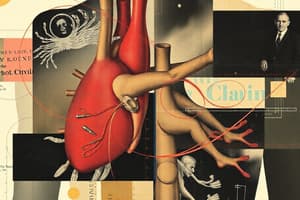Podcast
Questions and Answers
What is the primary mechanism of action of indirect-acting cholinomimetics in treating glaucoma?
What is the primary mechanism of action of indirect-acting cholinomimetics in treating glaucoma?
- Facilitate outflow of aqueous humor (correct)
- Reduce ciliary body contraction
- Block adrenergic receptors
- Increase aqueous humor production
Which condition is NOT effectively treated by neostigmine?
Which condition is NOT effectively treated by neostigmine?
- Chronic obstructive pulmonary disease (correct)
- Congenital megacolon
- Urinary retention
- Paralytic ileus
What is the result of high (toxic) concentrations of cholinesterase inhibitors at the neuromuscular junction?
What is the result of high (toxic) concentrations of cholinesterase inhibitors at the neuromuscular junction?
- Excessive sweating
- Severe muscle fasciculation (correct)
- Increased muscle strength
- Enhanced muscle contraction
What is the main pharmacokinetic characteristic of atropine?
What is the main pharmacokinetic characteristic of atropine?
Which of the following organ system effects is associated with scopolamine administration?
Which of the following organ system effects is associated with scopolamine administration?
Which clinical effect may result from an overdose of muscarinic stimulants?
Which clinical effect may result from an overdose of muscarinic stimulants?
How do anticholinergics like atropine primarily exert their effects?
How do anticholinergics like atropine primarily exert their effects?
Which agent is commonly used to diagnose myasthenia gravis?
Which agent is commonly used to diagnose myasthenia gravis?
Which of the following is a simple alcohol cholinesterase inhibitor?
Which of the following is a simple alcohol cholinesterase inhibitor?
What effect does pralidoxime have on organophosphates?
What effect does pralidoxime have on organophosphates?
Which cholinesterase inhibitor is poorly absorbed from the skin and lungs due to low lipid solubility?
Which cholinesterase inhibitor is poorly absorbed from the skin and lungs due to low lipid solubility?
How does edrophonium prevent the action of acetylcholine?
How does edrophonium prevent the action of acetylcholine?
What is the main clinical effect of high doses of lipid-soluble cholinesterase inhibitors on the CNS?
What is the main clinical effect of high doses of lipid-soluble cholinesterase inhibitors on the CNS?
Which of the following is a common pharmacokinetic property of organophosphate cholinesterase inhibitors?
Which of the following is a common pharmacokinetic property of organophosphate cholinesterase inhibitors?
What mechanism does carbamate esters use to inhibit cholinesterase activity?
What mechanism does carbamate esters use to inhibit cholinesterase activity?
Which organ system is affected by cholinesterase inhibitors in terms of causing bradycardia?
Which organ system is affected by cholinesterase inhibitors in terms of causing bradycardia?
Flashcards
Indirect acting cholinomimetics
Indirect acting cholinomimetics
Substances that enhance the effects of acetylcholine by inhibiting acetylcholinesterase, the enzyme that breaks down acetylcholine.
Acetylcholinesterase
Acetylcholinesterase
An enzyme that breaks down acetylcholine, terminating its effect at the cholinergic synapse.
Cholinesterase Inhibitors
Cholinesterase Inhibitors
Drugs that inhibit the enzyme acetylcholinesterase, leading to heightened acetylcholine activity.
Organophosphates
Organophosphates
Signup and view all the flashcards
Carbamates
Carbamates
Signup and view all the flashcards
Pralidoxime
Pralidoxime
Signup and view all the flashcards
Mechanism of Action (Edrophonium)
Mechanism of Action (Edrophonium)
Signup and view all the flashcards
Mechanism of Action (Organophosphates)
Mechanism of Action (Organophosphates)
Signup and view all the flashcards
Neuromuscular Junction
Neuromuscular Junction
Signup and view all the flashcards
Myasthenia Gravis
Myasthenia Gravis
Signup and view all the flashcards
Cholinesterase Inhibitors
Cholinesterase Inhibitors
Signup and view all the flashcards
Glaucoma treatment
Glaucoma treatment
Signup and view all the flashcards
Anticholinergics
Anticholinergics
Signup and view all the flashcards
Atropine
Atropine
Signup and view all the flashcards
Mydriasis
Mydriasis
Signup and view all the flashcards
Paralytic Ileus
Paralytic Ileus
Signup and view all the flashcards
Study Notes
Indirect Acting Cholinergic Agonists (Cholinesterase Inhibitors)
- Acetylcholine action is terminated by hydrolysis via acetylcholinesterase in cholinergic synapses.
- Indirect acting cholinergic agonists inhibit acetylcholinesterase.
Chemistry
- Cholinesterase inhibitors are categorized into three chemical groups:
- Simple alcohols (e.g., edrophonium): Reversibly bind electrostatically to the cholinesterase active site, preventing access of acetylcholine. The enzyme-inhibitor complex is short-lived (2-10 minutes).
- Carbamic acid esters of alcohols (carbamates, e.g., neostigmine, physostigmine, pyridostigmine): Bind to the active site and undergo hydrolysis, then form a covalent bond with the enzyme, inhibiting enzyme activity for 30 minutes to 6 hours.
- Organic derivatives of phosphoric acid (organophosphates, e.g., echothiophate, malathion, parathion, soman): Undergo initial binding and hydrolysis, resulting in a phosphorylated active site. The covalent phosphorus-enzyme bond is extremely stable and hydrolyzes at a very slow rate (hundreds of hours). The complex can undergo aging, further strengthening the bond.
Pharmacokinetics
- Quaternary carbamates (e.g., neostigmine) are poorly absorbed from skin, eyes, and lungs due to poor lipid solubility.
- Tertiary amines (e.g., physostigmine) are well absorbed and can be used topically in the eye. Physostigmine crosses the blood-brain barrier (BBB) and is more toxic than quaternary carbamates.
- Organophosphates (except echothiophate) are well absorbed from skin, lungs, gut, and conjunctiva. They penetrate the CNS. They are dangerous to humans and effective insecticides.
Mechanism of Action
- Edrophonium (simple alcohol): Reversibly binds electrostatically and via hydrogen bonds to the active site of cholinesterase enzyme, preventing access of acetylcholine.
- Carbamate esters: Bind to the active site, undergo hydrolysis, and then form a covalent bond with the enzyme, inhibiting enzyme activity.
- Organophosphates: Undergo initial binding and hydrolysis, resulting in a phosphorylated active site. The covalent phosphorus-enzyme bond is very stable and hydrolyzes slowly. The complex can undergo aging, further strengthening the bond. Pralidoxime is able to break the phosphorus-enzyme bond if given before aging has occurred.
Organ System Effects
- CNS: High doses of lipid-soluble agents can cause convulsions, coma, and respiratory arrest.
- Eye, Gastrointestinal (GI) Tract, Respiratory Tract, and Urinary Tract: Effects similar to direct-acting cholinergic agonists.
- Cardiovascular System (CVS): Bradycardia and reduced cardiac output.
- Neuromuscular Junction: Low concentrations increase the strength of contraction of weakened muscles (e.g., myasthenia gravis). High concentrations can lead to fasciculation of muscle fibers and neuromuscular blockade.
Clinical Uses
- Eye: Useful in glaucoma (increased intraocular pressure) by causing contraction of the ciliary body, facilitating outflow of aqueous humor. Physostigmine is commonly used.
- Gastrointestinal (GI) and Urinary Tract: Neostigmine can be used to increase smooth muscle activity in conditions like paralytic ileus, congenital megacolon, reflux esophagitis, and urinary retention.
- Neuromuscular Junction: Cholinesterase inhibitors (e.g., pyridostigmine) are useful for managing myasthenia gravis. Edrophonium can diagnose myasthenia gravis by observing improved muscle strength, and it can also be used to reverse post-surgical neuromuscular blockade.
Toxicity
- Overdose (e.g., organophosphate poisoning): Muscarinic effects such as nausea, vomiting, diarrhea, urinary urgency, salivation, sweating, and bronchoconstriction. These effects are blocked by atropine.
- Atropine (anticholinergic) overdose: Can manifest as dry mouth, mydriasis (pupil dilation), tachycardia, hot and flushed skin, agitation, and delirium.
Other Notes
- Anticholinergics (also known as antimuscarinics or parasympatholytics) are divided into muscarinic and nicotinic subgroups.
- Atropine (hyoscyamine) is the prototype drug found in the plant Atropa belladonna. Other examples include scopolamine and homatropine.
- Atropine is well absorbed from the gut and conjunctiva, widely distributed in the body including the CNS, and approximately 50% is excreted unchanged in the urine.
- Atropine causes a reversible (surmountable) blockade of cholinomimetic actions at muscarinic receptors.
- Clinical uses of anticholinergics include CNS disorders (e.g., Parkinson's disease, motion sickness), eye conditions, respiratory disorders (e.g., asthma, COPD), and cholinergic excess (e.g., organophosphate poisoning).
Studying That Suits You
Use AI to generate personalized quizzes and flashcards to suit your learning preferences.
Related Documents
Description
This quiz explores the chemistry and mechanisms of indirect acting cholinergic agonists, specifically cholinesterase inhibitors. Understand the classifications, actions and duration of different chemical groups of these inhibitors including simple alcohols and organophosphates.





